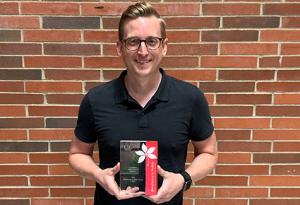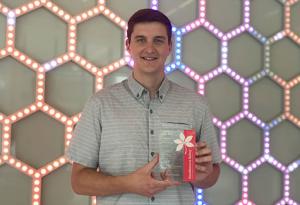The University Laboratory Safety Committee (ULSC) at The Ohio State University recognizes recipients of the fourth annual “Excellence in Safety” Award. The award recognizes three categories of those who have made a considerable contribution to improving laboratory safety on the Ohio State campus: a university faculty or staff member (Staff Award), an undergraduate or graduate student (Student Award) and a laboratory research group (Group Award). Such contributions can be defined as but are not limited to actions taken to prevent injury or illness, outstanding response and cooperation given to resolve unsafe conditions, consistent improvement during laboratory inspections, or any other consistent and proactive demonstration of efforts in support of a positive laboratory safety culture.
Congratulations to all of the 2021 award winners! Thank you for making The Ohio State University a safe working and learning environment for everyone!
Faculty/Staff Award - Laboratory Supervisor Jeff Jahnes, Department of Microbiology, is the point person for all safety issues in the department, including being the liaison with Environmental Health and Safety and serving as the chair of the departmental safety committee. He facilitates safe practices in all of the research and teaching laboratories, manages certifications for laboratory equipment relevant to safety (biosafety cabinets, fume hoods, etc.), and facilitated efforts to ready the departmental flow cytometer for handling biohazardous agents (live pathogens), a capability that other flow cytometers at the university lack. For the departmental teaching program, Jeff instigated the provision of lab coat service to all of our students, numbering in excess of 800 annually, and expanded this program to all departmental research laboratories. He has done much planning for converting some of the teaching space to BLS-2 and took the lead in planning and implementing the department's response to the COVID-19 pandemic, representing the department in planning activities with the college, EHS and the university. Most significantly, he has led the development and operations of the university's in-house SARS-Cov-2/COVID-19 testing facility, handling in excess of 50,000 samples weekly with a turnaround time of 3 hours. At the time of this current award nomination, his effort resulted in more than $8 million in savings to the university, with a projected savings in excess of $20 million. Overall, his contributions have been instrumental in the university's ability to maintain on-campus activities and to keep the university population safe and health during a difficult time.
Student Award - Chairperson of the joint safety committee Michael Scudder has collaborated with a cadre of like-minded graduate students to maintain an excellent safety program in the Department of Chemistry and Biochemistry. Michael leads the Joint Safety Team (JST) with Laboratory Safety Officers appointed for each research lab - serving as liaisons with faculty, staff, and students - organizing the monthly meetings and setting the agendas. Their concerted efforts have promoted a "lab clean-up day" in which researchers discarded old chemicals and equipment, made air aspirators and recirculation pumps available to laboratories to reduce water consumption, and coordinated the first Industry Day with a speaker from Dow Chemical espousing laboratory safety. The event launched several collaborative projects with Dow and other universities.
Group Award - Chemical Hygiene Committee in the College of Engineering - Saurabh Ailawar, Jee-Yee Chen, Ting Yu Chen, Yu-Yen Chen, Ross Chongson, Xuepeng Deng, Kayane Dingilian, Leigh Evrard, Jackelyn Galiardi, Vance Gustin, Yang Han, Richard Hickey, Kalyani Jangam, Elizabeth Jergens, Faiz Khan, You Li, Qiang Lyu, Brian Marshall, Qichang Meng, Adil Rather, Xilal Rima, Kevin Shen, Alex Spanos, Haibin Sun, Tong Sun, Vyom Thakker, Xinyu Wang, Mitchell Weigand, Savannah Wolfe, Yang Xu, Fengli Zhang, Jingjing Zhang, Pete Znidarsic. The mission of this student-led organization is to bring consistency and continuity of safety practices across the department's research laboratories, meeting regularly with Environmental Health and Safety and with the College of Engineering representatives. One highlight is their self-inspection process, developed in conjunction with EHS and focusing on the highest risk rankings and most frequently missed items on the EHS checklist. This effort has improved safety awareness, focusing on a proactive vs. reactive approach to safety. A hallmark of this committee is its intense cross-training protocol to accommodate turnover. It has implemented a program requiring at least two members per lab to be capable of serving as safety officers, with at least one not in their final year. This has provided a pathway to ensure laboratory members are properly trained and that key safety practices are procedures are not lost by attrition. The committee also has implemented a self-inspection protocol throughout the year to ensure that laboratories are maintaining good safety standards consistently, not just during "inspection season." Additionally, the committee has implemented a reporting tool through CBEC, further adding to an overall safety environment. One of the committee members, certified as a first aid trainer, conducts monthly training classes to the members of the department. The committee excelled in its response to the recent pandemic, with representatives working closely with the College of Engineering safety coordinator to ensure appropriate safety measures in accordance with guidelines from the Centers for Disease Control and the university. The group regularly discussed safety protocols and PPE, rotated work schedules, and implemented methods to reduce risk.



